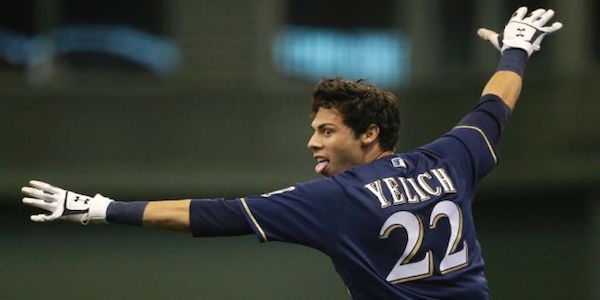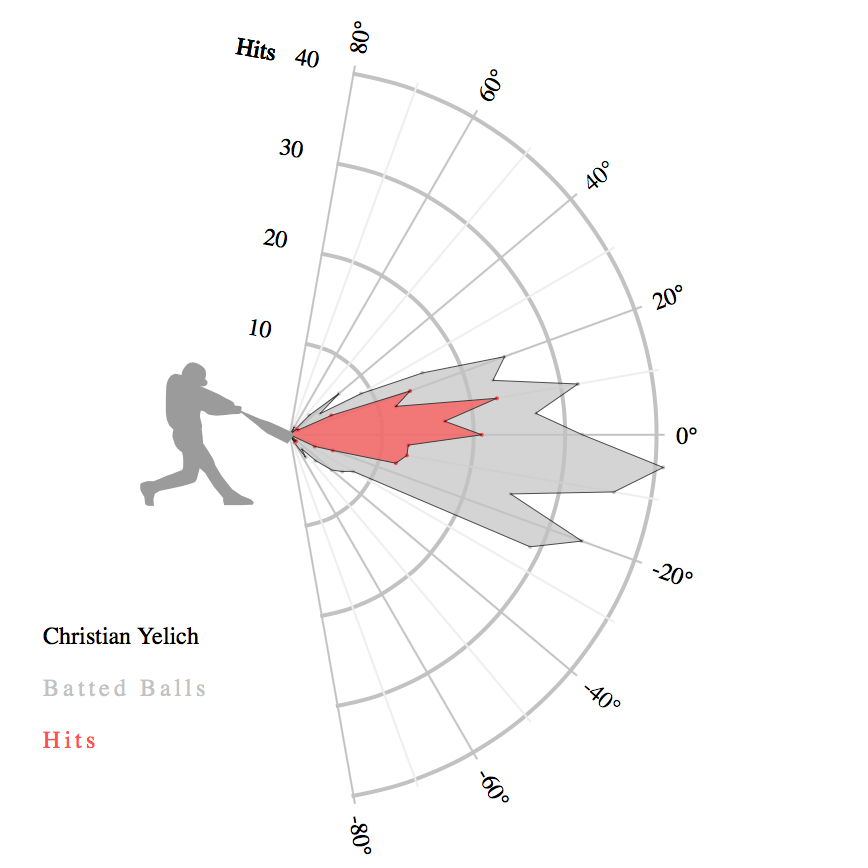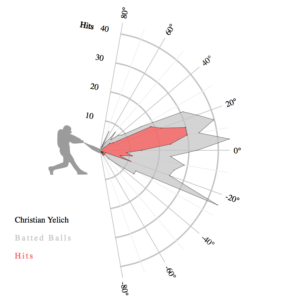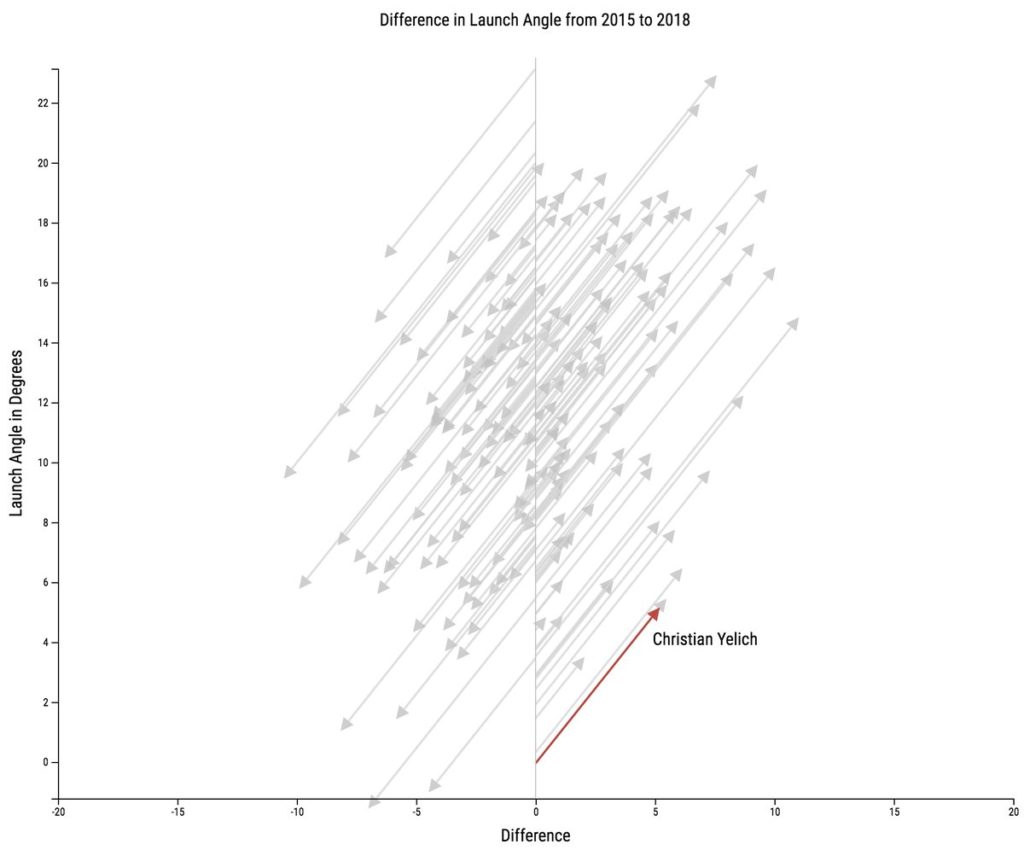Christian Yelich’s Change in Batted Ball Profile Launches Him To Top of Fantasy Baseball Drafts

Way back there in the rearview mirror one may be able to catch a glimpse of the quantity-for-quality 4-for-1 player swap between the Marlins and the Brewers that landed Christian Yelich in Milwaukee this time last year. Yelich, one of the most sought after assets on the Miami Marlins who were in the middle of stripping down their roster in favor of a rebuild, was an incredible talent on a team friendly contract ready to roam the greener pastures of Miller Park.
The former first-round pick possessed all the tools at the plate teams in real life that teams love. Makes contact. Hits for average. Takes walks. Doesn’t strike out all that much. And when he’s on the paths can wreak some havoc.
But the perpetual knock on the outfielder for fake baseball purposes was that he hit the ball into the dirt all too often. Yelich posted an alarming 61% ground ball rate in 2014 — the fourth highest in the first division behind only Ben Revere, Nori Aoki and Derek Jeter (league average was 44.8%). Fortunately for Yelich, speed is one of his greatest assets and still managed a .284 average courtesy of a .359 batting average on balls in play. The lack of fly balls left traditional fantasy players missing out on important category production in the home run department (nine in ‘14), subsequently impacting the runs and runs batted in categories. Yelich posted a 17.8% FB% in ’14, the fourth-lowest fly ball rate among players with a minimum of 300 at-bats.
2015 was worse for Yelich despite posting an average exit velocity of 91.4 mph (top 8% in MLB) and a 45.3% Hard Hit% (top 9% in MLB). The batting average was up, but production in each of the other four traditional fantasy categories took a hit (runs, home runs, runs batted in & stolen bases) although we know not all of fantasy categories can be directly attributed to the skills he owns (his team was terrible!). Both Yelich’s GB% (62.5%) and FB% (15%) turned out to be the worst marks in the majors and in his short career. Throughout all of this it’s important to note that Yelich maintained average strikeout rates and an above average ability to take a free pass.
The approach appeared to start changing for Christian Yelich in 2016, though. His batted ball profile began to trend positively in each of the ground ball, line drive and fly ball department starting in 2016. The ground ball rate dipped to 56.5% with one percent of the difference being added to the line drive rate (23.4%) and a full five point spike in his fly ball rate (20%). Despite the improvements, the ground ball rate was still fourth-lowest in the Majors and the fly ball rate was second-lowest among qualified bats. However, the improvement in fly balls along with a couple of extra gusts of wind heading out from home plate (23.6% HR/FB%) yielded a career best 21 home run effort.
In 2017 the positive trend continued. Another dip in GB% and LD% resulted in a career-best 25.2% fly ball rate. However, the HR/FB% regressed from 23.6% in ’16 to just 15.3% in ’17 leaving Yelich with just 18 moon shots, three short of his previous season’s performance. Exit velocity and hard hit rate continued to place Yelich among the top 4 and 5 percent of his peers, respectively.
Then the move to Milwaukee. For Yelich it was a major team and park upgrade. He continued to hit fewer ground balls (51.8%) in favor of line drives (24.7%) and fly balls (23.5%, down just a tick from ’17 but better than his career rates). Yelich’s average exit velocity (92.3, top 6% in MLB) was the second-best mark of his career while his hard hit rate jumped to a career best 50.8% (top 2% in MLB). The ISO jumped from .156 in 2017 to .272 in ’18 (insane!), while the home run per fly ball rate surged to a career and MLB-best 35%, just ahead of fellow mashers J.D. Martinez (29.5), Joey Gallo (27.6) and Giancarlo Stanton (25%). Outside of games played and the aforementioned FB%, Yelich boasted career bests in all other categories discussed above leading him to be crowned the National League’s Most Valuable Player.
The team and park contributed greatly to Yelich’s MVP campaign. But the gradual changes he made to his batted ball profile up until that point shouldn’t be ignored. We discussed the changes in GB% to LD% and FB% throughout the piece, which seems to be a case of Yelich lifting the ball better than he ever has before. Take a gander at the following charts courtesy of our friend Darren at Baseball Savant as the launch angle moved from 0 in ’15, to 2.5 in ’16 and 4.7 in ’17 and ’18.


We have (more) lift off. Here’s another look at the difference in launch angles for MLB players between 2015-2018, Christian Yeluch highlighted toward the bottom:

The change is real. Not only, in the team and park, but the swing. The improved launch angle paired with elite exit velocity and hard hit rate is aiding Christian Yelich’s ability to hit the ball (farther) in the air, but he’s not selling out to do so like others have. He’s maintaining an excellent batting average without too much change in strikeout or walk rates. A true five category machine.
The real question we have is will he able to (mostly) repeat this 2018’s performance? Maybe. One of the numbers in question is the 35% HR/FB%. It’s a mark that’s insanely high (in general, for all MLB bats) and abnormal for his skill set compared to career rates despite the change batted ball profile. It’s probable that much of the in skills for Yelich remain in tact, but the HR/FB% and potentially BABIP, being the other number, somewhat correct themselves. If they do indeed come back to earth, we could be looking at more of a 25-28 homer/20 stolen base season at about .300.
If that projection is reasonable, does that make a .300 hitter with 100 runs, 90 RBI, 25-28 homers, 20 stolen bases worth their current draft price? According to early NFBC average draft position data, Yelich is going off the board about 7th overall but has been picked as high as 1st and as low as 14th in 15-teamers. To compare, in last evening’s Mixed LABR draft, Jake Ciely pounced on Yelich at 4 and a couple of weeks earlier Yelich fell to 10th overall to Jeff Mans and Ted Schuster in the 15-team FSTA Expert Draft. Without any regression Yelich belongs at the top of the first round, so it will be interesting to see if he can own the newly found HR/FB% and BABIP rates going forward. But for now, if given the choice, I’d prefer to pass on Yelich in the early parts of the first round and gun for someone with similar projected output like Trevor Story (current NFBC ADP: 17) or Charlie Blackmon (current NFBC ADP: 26) who could be had in the 2nd round or a Juan Soto-ish (current NFBC ADP: 31) type outfielder in the third or early fourth rounds.





